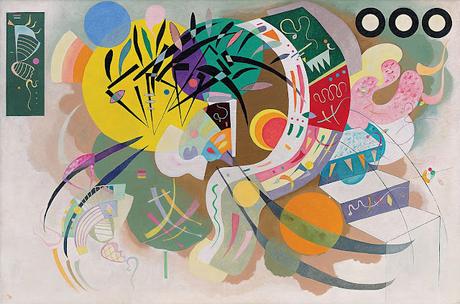
Vasily Kandinsky, Dominant Curve, April 1936
VASILY KANDINSKY - Around the circle
Salomon R. Museum (New York) jusqu'au 5 septembre 2022
En géométrie euclidienne, un cercle est une courbe plane fermée constituée des points situés à égale distance d'un point nommé centre
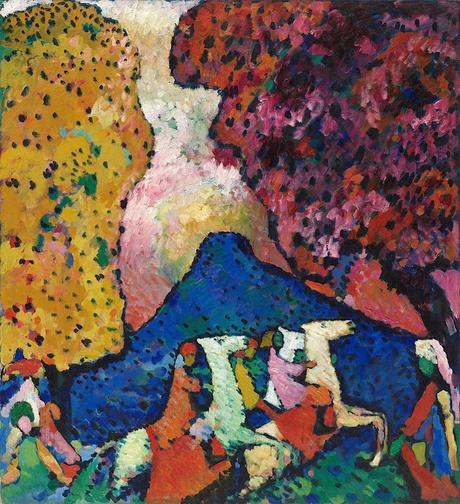
Vasily Kandinsky, Blue Mountain, 1908–09
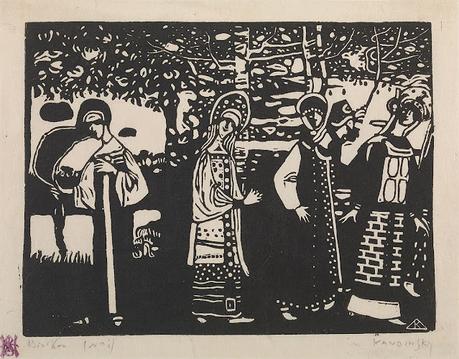
Vasily Kandinsky, Women in the Woods, 1907
Vassily Kandinsky est reconnu comme un innovateur artistique majeur et un théoricien de la peinture. Dans les premières décennies du vingtième siècle, il a été parmi ceux qui ont fait progresser les modes de création artistique non figuratifs avec un effet durable. L'évolution stylistique de l'artiste à cet égard était intimement liée à son sentiment d'appartenance et aux communautés avec lesquelles il s'engageait. Kandinsky a acquis un aperçu des intersections significatives avec des artistes, des musiciens, des poètes et d'autres producteurs culturels, en particulier ceux qui partageaient sa vision transnationale et son penchant expérimental.

Vasily Kandinsky, Landscape with Factory Chimney, 1910

Vasily Kandinsky, Improvisation 28 (Second Version) (Improvisation 28 [zweite Faßung]), 1912
Déraciné à maintes reprises, il s'est adapté à chaque déménagement à travers l'Allemagne, de retour en Russie et finalement en France, le tout dans le contexte des bouleversements sociopolitiques qui se produisent autour de lui. Dans cette exposition, le travail de Kandinsky se déroule dans l'ordre chronologique inverse, en commençant par ses peintures de fin de vie et en remontant le long de la rampe en spirale du Guggenheim.
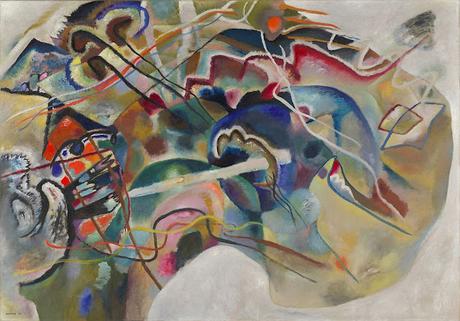
Vasily Kandinsky, Painting with White Border, May 1913
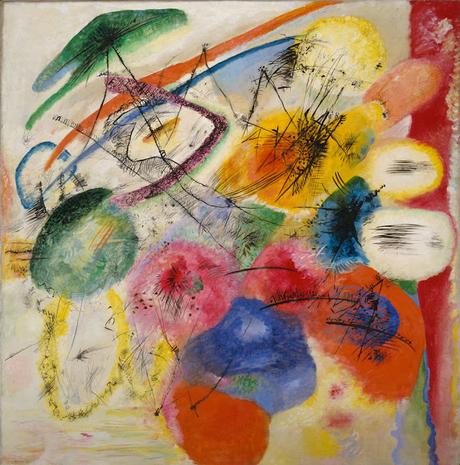
Vasily Kandinsky, Black Lines (Schwarze Linien), December 1913
Il ne s'agissait pas d'un chemin fixe de la représentation à l'abstraction, mais plutôt d'un passage circulaire traversant des thèmes persistants centrés sur la poursuite d'un idéal dominant : l'impulsion à l'expression spirituelle. Ce que Kandinsky a appelé la «nécessité intérieure» de l'artiste, est resté le principe directeur à travers les redéfinitions périodiques de sa vie et de son œuvre.
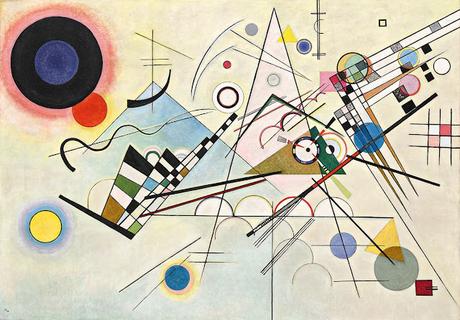
Vasily Kandinsky, Composition 8 (Komposition 8), July 1923
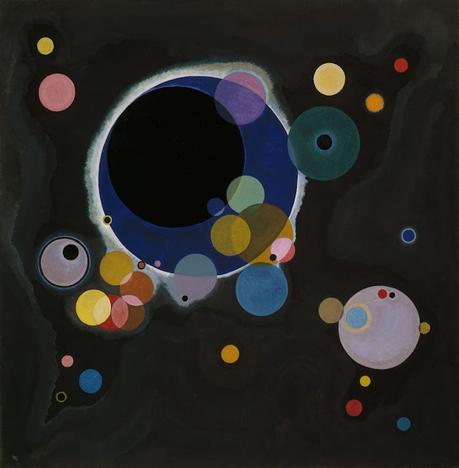
Vasily Kandinsky, Several Circles (Einige Kreise), January–February 1926.
L'exposition commence par la dernière période de Kandinsky qui se déroule en France. Les sciences naturelles et le mouvement surréaliste, ainsi qu'un intérêt constant pour les pratiques culturelles et le folklore russe et sibérien, ont formé son imagerie organique et suscité des thèmes récurrents de renouveau et de métamorphose. Les peintures de sa décennie d'enseignement au Bauhaus, manifestent la conviction de Kandinsky que l'art peut transformer soi-même et la société ainsi qu'illustrer la revitalisation de son style « non concret » à la suite d'un contact direct avec l'avant-garde en Russie. La dernière section de l'exposition examine les premières peintures de Kandinsky, réalisées alors qu'il vivait dans les environs de Munich. Là, il a participé à une activité d'avant-garde dans de multiples disciplines, se déplaçant avec fluidité entre la peinture, la poésie et la composition scénique, par exemple.

Vasily Kandinsky, Gloomy Situation (Trübe Lage), July 1933
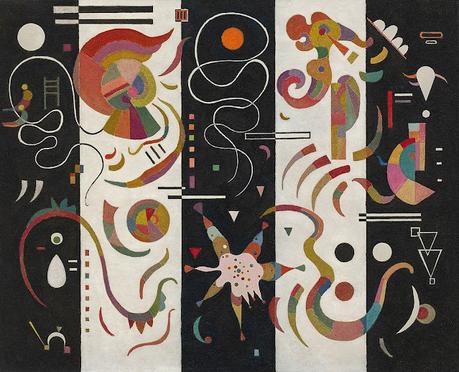
Vasily Kandinsky, Striped, November 1934
Au cours de sa carrière, l'artiste a interrogé les possibilités expressives de la couleur, de la ligne et de la forme. À chaque instant, Kandinsky a répondu à son environnement et a développé de nouvelles façons de sonder le spirituel dans l'art. Ces peintures, aquarelles et gravures sur bois tirées de la vaste collection Kandinsky du musée éclairent le parcours d'un artiste qui ne laissait pas derrière lui les précédents de la représentation ou de son propre travail, alors même qu'il explorait le potentiel transcendant des formes abstraites.

Vasily Kandinsky, Capricious Forms, July 1937
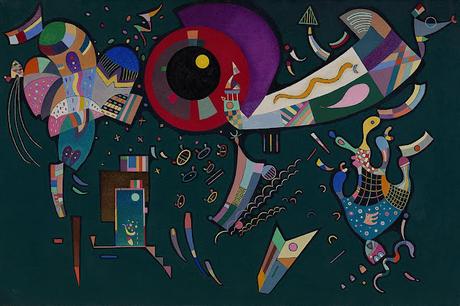
Vasily Kandinsky, Around the Circle, May–August 1940
Une facette méconnue de l'oeuvre de Kandinsky :
Les peintures sur verre de Kadinsky
Une petite bio de Kandinsky (en anglais)
Vassily Kandinsky was born on December 16, 1866, in Moscow. From 1886 through 1892 he studied law and economics at the University of Moscow, and in 1889 he undertook an ethnographic expedition in the Vologda province in northern Russia. He later declined a teaching position in order to study art in Munich with Anton Ažbe from 1897 to 1899 and at the Kunstakademie with Franz von Stuck in 1900. Kandinsky taught in1901–03 at the art school of the Phalanx, a group he cofounded in Munich. One of his students, the German artist Gabriele Münter, would be his companion until 1914. In 1902 Kandinsky exhibited for the first time with the Berlin Secession and produced his first woodcuts. In 1903 and 1904 he began his travels in Italy, the Netherlands, and Tunisia and made visits to Russia. He showed at the Salon d’Automne in Paris from 1904.
In 1909 Kandinsky was elected president of the newly founded Neue Künstlervereinigung München (NKVM), whose first show took place at Heinrich Thannhauser’s Moderne Galerie in Munich later that year. In 1911 Kandinsky and Franz Marc formed Der Blaue Reiter, a loose confederation of artists, writers, and musicians, and began to make plans for Der Blaue Reiter Almanac, although the publication would not appear until the following year. Kandinsky’s seminal treatise On the Spiritual in Art was published in December 1911. He and Marc withdrew from the NKVM that month, and shortly thereafter the Blaue Reiter group’s first exhibition was held at the Moderne Galerie. In 1912 the second Blaue Reiter show was held at the Galerie Hans Goltz, Munich. Kandinsky’s first solo show was held at Der Sturm gallery in Berlin in 1912. In 1913 one of his works was included in the Armory Show in New York and the Erste deutsche Herbstsalon at the Der Sturm gallery in Berlin. Kandinsky lived in Russia from 1914 to 1921, principally in Moscow, where he held a position at the People’s Commissariat of Education.
Kandinsky began teaching at the Bauhaus in Weimar, Germany, in 1922. In 1923 he was given his first solo show in New York by the Société Anonyme, of which he became vice-president. Lyonel Feininger, Alexei Jawlensky, Kandinsky, and Paul Klee made up the Blaue Vier group, formed in 1924. Kandinsky moved with the Bauhaus to Dessau in 1925 and became a German citizen in 1928. After the Bauhaus closed under pressure from the Nazi government in 1933, Kandinsky settled in Neuilly sur-Seine, near Paris; he acquired French citizenship in 1939. Fifty-seven of his works were confiscated by the Nazis in the 1937 purge of so-called “degenerate art.” Kandinsky died on December 13, 1944, in Neuilly.